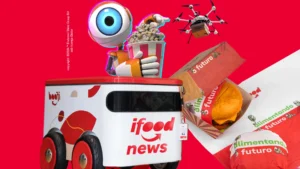Discover how this friendly little robot manages to locate itself and overcome obstacles to improve efficiency in iFood deliveries
The ADA robot It has already become known in the corridors of Shopping Iguatemi in Ribeirão Preto. Since 2021, it has been picking up orders from restaurants that are furthest from the food court and taking it to the hub where delivery people pick up the food to take to customers' homes.
In 2022, ADA is expanding its horizons, and has already started touring a condominium of houses, also in Ribeirão, where iFood is testing this type of delivery. But how can this nice little machine reduce delivery time and optimize the work of delivery drivers (all of this without polluting the environment)?
This is a story of Brazilian 100% innovation, with a lot of artificial intelligence. ADA was born from a partnership between iFood and Synkar, a national company specializing in artificial intelligence. She is an intelligent and extremely cautious robot: no incidents have been recorded so far.
At iFood, it operates in the first and last mile of delivery, that is, when the order leaves the restaurant and reaches the hands of the delivery people (first mile) and when the delivery people arrive at the destination to complete the delivery (last mile). “At the mall, the first mile took 15 minutes. With ADA, we reduced this time by 40%”, explains Lucas Assis, CTO and co-founder of Synkar.
In condominiums, ADA is being tested to act in the last mile and promote safe and contactless delivery for the customer — in addition to optimizing the time of delivery people, who only need to leave the order at the condominium entrance, as whoever takes the food even every house is a robot.
How ADA works
Walking alone in a closed or open environment with moving or static obstacles seems very complex. After all, how does the robot know the route from the restaurant to the iFood hub? And what happens when an obstacle appears on the path?
It handles all of this with the support of some types of artificial intelligence. “There is no single solution that controls everything, but dozens of techniques used together to arrive at a solution like ADA”, explains Lucas. There is, therefore, an artificial intelligence and robotics technique for navigation, another for localization and another for perception.
In short: ADA has more than ten cameras, with different characteristics, that support this entire operation. It is from the cameras that the robot's artificial intelligence can detect an obstacle and make a decision, such as avoiding this obstacle or stopping completely until a moving obstacle (such as an adult, a child or an animal) passes by it.
Another artificial intelligence technique allows, when traveling through an external environment, the ADA to know how to differentiate what is a sidewalk, street, grass, bike path or tree, for example. She can also know where she is and how to find her way around, even in a closed environment.
Lucas explains that, for this to happen, ADA takes a first tour, in which it records this entire digital repository in your mind. “From this, it creates a 3D visual memory of the environment so it knows where it is”, explains the CTO.
The robot that does (almost) everything alone
ADA knows exactly what it needs to do and the path it needs to take to get the order to a delivery person or customer. But sometimes unforeseen events happen. It could be a change of decoration at the mall for Christmas, for example, or a temporary closure along the way. And there?
The little robot is also equipped with some metrics that determine whether the environment recorded in its memory corresponds well with the “real” environment. When this index drops, someone needs to take the ADA to do a new field reconnaissance and understand what has changed.
If, by chance, the robot does not find a solution, then it takes a very “human” attitude: it asks for help. And the command and control center that monitors the operation takes over ADA's actions when it cannot resolve something or is in doubt about the best option.
From this center, a person can access the robot's cameras and information about what it was doing, what it saw and why it decided to ask for help. This set of information will be used so that a human being can make the best decision.
“In a condominium with a street with a slightly higher flow of vehicles, for example, our system calls the operator to carry out supervision and he is able to control the robot so that it crosses the street. Then it becomes autonomous again and makes the delivery”, explains Lucas.
ADA’s next evolutions
The ADA is already going a long way, but it doesn’t stop here. The objective is to have a more independent robot, which can interact more with people and carry out more trips. This is the tripod of improvements for the next version of ADA based on everything learned in Ribeirão Preto.
One of the planned improvements is for ADA to combine the information it receives during its missions to improve its memory and thus ask less for help from humans. Another point is to provide it with more light signs, screens, speakers and microphones to improve interaction between robot, delivery person and customer. And to improve its batteries to increase its autonomy in service.
For now, ADA is only operating in Ribeirão Preto but the plans are for expansion, both for operations in shopping malls and condominiums. Will we one day see the little robot on the streets, making deliveries?
“ADA will not replace our delivery drivers in the future. It is a solution to improve efficiency on complicated and time-consuming journeys for delivery people, such as having to travel within shopping malls and large condominiums”, says Fernando Martins, head of logistics and innovation at iFood.


